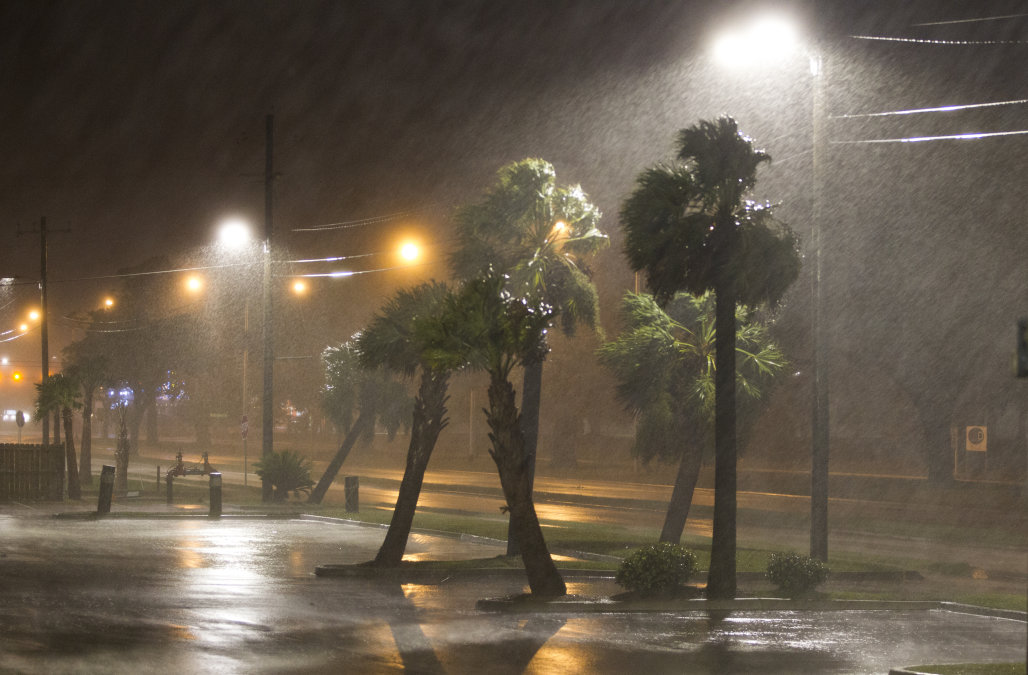
NEW ORLEANS, (Reuters) – Tropical Storm Nate rapidly weakened as it moved over Alabama today, although the fast-moving former hurricane rattled the doors of Biloxi’s casinos and left gambling floors and highways in the region flooded after making its landfall in Mississippi.
Its maximum sustained winds dropped to 45 miles per hour (70 km per hour) as it moved northeast into Alabama, prompting the National Hurricane Center to end its tropical storm warning for the region east of the Alabama-Florida border on Sunday morning. Only a few hours earlier it had been blowing at 70 mph (110 km per hour), but Nate appeared to lack the devastating punch of its recent predecessors.
The fourth major storm to strike the United States in less than two months, Nate killed at least 30 people in Central America before entering the warm waters of the Gulf of Mexico and bearing down on the U.S. South. It has also shut down most oil and gas production in the Gulf.
Nate follows a succession of big Atlantic hurricanes, Harvey, Irma and Maria, that have devastated areas of the Caribbean and southern United States in the last two months.
The storm’s center will move inland over Mississippi and across the deep south, Tennessee Valley and Central Appalachian Mountains through Monday, the National Hurricane Center said. Heavy rainfall and storm surge flooding continued to be a danger across the region, the center warned.
Nate made its initial landfall near the mouth of the Mississippi river on Saturday evening and then made a second landfall early on Sunday near Boloxi, Mississippi, where its 46,000 residents were warned that the highest storm surge could reach 11 to 12 feet.
The storm surge brought flood waters over Highway 90 and up to oceanside casinos in Biloxi, while flood waters swept over streets in communities across Mississippi and Alabama, according to reports on social media.
“We have a restaurant and one of our main bars open so they have been ok so far,” said Chett Harrison, the general manager at the Golden Nugget hotel and casino in Biloxi where 300 guests were hunkered down.
“No one has tried to leave, thank goodness, because everything is flooded around us,” he told a local CBS TV affiliate.
In Hancock County, Mississippi, northeast of New Orleans, rain and wind were gaining intensity and many streets were washing over. Conditions were likely to worsen in the next few hours, said Brian Adam, director of emergency management for the county.
The county evacuated people from low-lying areas and imposed a curfew.
On Saturday states of emergency were declared in Louisiana, Mississippi and Alabama, as well as in more than two dozen Florida counties.
In Alabama Governor Kay Ivey urged residents in areas facing heavy winds and storm surges to take precautions.
At least 8,000 customers were without power in Mississippi, Mississippi Power reported, while more than a thousand people had arrived at shelters, the Mississippi Emergency Management Agency said. In Alabama, some 59,000 customers were without power, Alabama Power said.
Rainfall of 3 to 6 inches (7.6 cm to 15.2 cm), up to a maximum of 10 inches, were expected east of the Mississippi River from the central Gulf Coast into the Deep South, in the eastern Tennessee Valley, and southern Appalachian mountains, the NHC said.
Rainfall in the Ohio Valley and into the central Appalachians could be 2 to 5 inches with a maximum of 7 inches.
NEW ORLEANS THREAT DOWNGRADED
New Orleans Mayor Mitch Landrieu lifted a curfew in the city on Saturday evening that was originally scheduled to last until Sunday morning. He said in a statement on social media however, that there was still a serious threat of storm surge outside levee areas.
Major shipping ports across the central U.S. Gulf Coast were closed to inbound and outbound traffic on Saturday, as Nate intensified and storm surges of up 11 feet were expected at the mouth of the Mississippi River.
The storm curtailed 92 percent of daily oil production and 77 percent of daily natural gas output in the Gulf of Mexico, more than three times the amount affected by Harvey.
Workers were evacuated from 301 platforms and 13 rigs as of Saturday, said the U.S. Bureau of Safety and Environmental Enforcement.
The storm doused Central America with heavy rains on Thursday, killing at least 16 people in Nicaragua, 10 in Costa Rica, two in Honduras and two in El Salvador.
